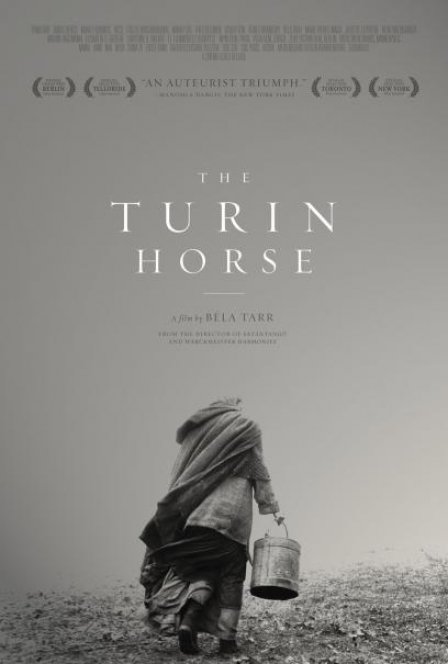Consisting of nothing more than increasingly apocalyptic yet overwhelmingly mundane days in the life of two destitute peasants, the plot of Béla Tarr’s latest film is about as barebones as it gets, even by his own imposingly glacial standards. Offering precious little in the way of action aside from a daily meal of a single potato, grueling slogs to the well, and the bellicose stasis of their horse, Tarr forces viewers to extract meaning from his formidable aesthetic techniques as a sort of compulsive reaction to the prodigiously overpowering boredom that quickly sets in once the realization is made that little else is going to be offered. Although his films are renowned for trying audiences’ patience through his reliance on extended takes and nearly-static images, The Turin Horse is perhaps the first to make refusing the audience’s desire for stimulation a central element. While Tarr’s seven-and-a-half-hour Sátántangó is leavened by a consistent use of black humor and the attention-piquing intrigues of film noir convention, The Turin Horse offers a plot that offers precious few entertainments outside of its interpretation. This dearth of traditional interest, however, becomes a distinct tool in the hands of Tarr, opening up new ways of viewing and interpreting, even within his body of work. The Turin Horse is dull to the extreme, yes, but its dullness is forced into becoming an asset.
The film’s opening shot provides the most visual variety the film has to offer, as the camera slowly prowls around the titular horse and its carriage driver as they rush along a muddy path in a display of shocking cinematic technique and control. Set to a gorgeously depressive score from constant collaborator Mihaly Vig, the shot is a masterpiece of controlled movement; yet from this point on, the film moves to a still further delineated style. The roving camera still impresses with its ingenuity and rigor, but such an acknowledgement of virtuosity can only be applied retroactively, as its movement is so slow that it quickly recedes from the viewer’s conscious analysis. The mind is tossed between a bleakly pleasurable immersion in the slowly shifting, decadently crumbling beauty of Tarr’s black-and-white compositions and a fervent search for some new element of stimulation not offered by the ruthless stasis of his protagonists. In an amplified form of the workings of his previous films, each flickering change of light and each new gust of wind from the ceaseless gale become the focus of the film in its minute-to-minute unfolding.
Opening with a voiceover recounting of Nietzsche’s descent into madness, which follows a fevered attempt to stop the carriage driver from flogging the titular horse to death, Tarr gives us little choice but to interpret each new image through an explicitly philosophical frame. Given that the only clear moments of intertexuality in the film can be found in this opening voiceover and a later incident involving what appears to be a Satanic Bible, the viewer is forced to wrestle the film’s content into something resembling a cohesive worldview. If we were to sum this constructed outlook up succinctly, one might end up with a post-Nietzchian nihilism, inflected with an extreme displacement and rejection of human agency, ontological primacy, and any notion of transcendence. The plot’s machinations, such as they are, place Tarr’s characters at the bare mercy of his film world’s elements, stripping them to mere subjects of the whims of wind, water, or death; the camera does the same, each careful framing redefining their suffering as the raw material of an exacting formal expression.
Of course, such a reading treats the film only as text and ignores the sensual experience of watching it. As with any other Tarr film, the process of viewing complicates any expressed “message,” even as The Turin Horse virtually demands that we search for one. If there’s a critique to be leveled against the film, it’s certainly that it verges on an academic didacticism. But on the textural level of the film’s images, it works to combat such a critique, if only partially. With its bleak score, the sensuous immediacy of its stylized yet ravaged textures, and the languidly tragic poses of its actors, The Turin Horse has as much in common with a dance or a poem as it does with a traditional theoretical text, even if the rigor of its philosophical expression is maintained. The film plays with the divide between rhetorical and poetic meaning as much as it does with the tension between the boredom of meaninglessness and a constant search for meaning.
In this way, The Turin Horse is perhaps the most rarified expression of his style yet, which is appropriate given that Tarr has stated that it’s also his final film. In keeping with the title of “the last modernist” (as bestowed upon him by the Film Society of Lincoln Center), it’s a work in which aesthetics and thematic thrust merge to the point of being virtually indistinguishable. Occupying the uncomfortable place where aesthetic pleasure seeps into creeping nihilism, it’s certainly a tour de force of some sort. And if we take perfection as flawless adherence to a set of internal aesthetic rules, then The Turin Horse comes about as close to perfection as possible. Yet despite its focus on poetic and rhetorical meaning through form, the expression of that meaning opens up a gaping abyss in the place where transcendence or hope might reside. The Turin Horse presents a world in which the very beauty of the film itself is simply a howl into the void and death. It’s an impeccable tragedy, even if the term “tragedy” means very little by the end of its runtime.

